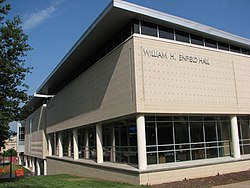This site is a developmental version of Wiki Law School. To go to the production site: www.wikilawschool.org
University of Arkansas School of Law
| University of Arkansas School of Law | |
| Parent school | University of Arkansas |
|---|---|
| Established | 1924 |
| School type | Public |
| Endowment | $84.2 million |
| Dean | Stacy L. Leeds |
| Location | Fayetteville, AR, US |
| Enrollment | 403 |
| Faculty | 58 (See List) |
| USNWR ranking | 84 |
| Annual tuition | |
| Website | law.uark.edu |
| Outlines | 0 (See List) |
University of Arkansas School of Law is located in Fayetteville, AR
The University of Arkansas School of Law is the law school of the University of Arkansas in Fayetteville, Arkansas, a state university. It has around 445 students enrolled in its Juris Doctor (J.D.) and Master of Law (LL.M) programs and is home to the federally funded National Agricultural Law Center and the nation's only LL.M in agricultural law program. The School of Law is one of two law schools in the state of Arkansas; the other is the William H. Bowen School of Law (University of Arkansas at Little Rock).
History
The School of Law was founded in 1924. The founding dean was Julian Waterman, a Dumas, Arkansas native and University of Chicago Law School graduate who led the school through its first 19 years, until his death in 1943.
The School met initially in the bottom floor of Old Main, and was approved by the American Bar Association two years later, in 1926. In 1927, the first class, consisting of ten students, graduated.
Over the next several decades, as the law school grew in size, it moved to larger accommodations. The 1930s saw a move to the Chemistry Building just to the southeast of Old Main, and then into Waterman Hall, the first dedicated law school construction project, in the 1950s. The latter half of the 20th century saw additions added to Waterman Hall to form the Robert A. Leflar Law Center.
On February 2, 1948, the University of Arkansas School of Law became the first Southern white university to accept an African-American student since Reconstruction. Silas H. Hunt, a World War II veteran who had been wounded in the Battle of the Bulge and following the conclusion of the war had completed an undergraduate degree in English at Arkansas Agricultural, Mechanical & Normal College applied to multiple law schools in 1947. He chose to seek entry at the Arkansas School of Law to challenge the system of racial segregation established in Arkansas at the time.[1] Accompanied by his attorney, Howard Flowers, Hunt met with the dean of the law school, Robert A. Leflar, who reviewed Hunt's application. Leflar was impressed and accepted Hunt's application to the law school. For a semester, Hunt attended the law school until succumbing to illness, and dying in a veteran's hospital on April 22, 1949, in Springfield, Missouri.[1]
Following Hunt's successful entry into the law school, five more African-American students applied and were accepted into the law school: George Williford Boyce Haley, who went on to become a United States Ambassador to The Gambia; Wiley Branton, who served as dean at the Howard University School of Law; Jackie L. Shropshire; Chris Mercer; and George Howard, Jr., who later became the first black United States district court judge in Arkansas.[2] Collectively they are known as the "Six Pioneers." Silas H. Hunt Hall, located adjacent to the Robert A. Leflar Law Center, honors Silas Hunt, in addition, to a historical marker in front of the law school.
In 2007, a Template:Convert addition to the Leflar Law Center was completed, expanding on the Young Law Library, as well as adding a coffee shop, four classrooms, a technologically equipped courtroom, and a formal entrance hall.
Facilities
The University of Arkansas School of Law is self contained within the Robert A. Leflar Law Center on the campus of the University of Arkansas in Fayetteville, which is located in Washington County in Northwest Arkansas at the edge of the rolling hills of the Ozarks.
The law center is a square facility with four wings that encompass a courtyard. It consists of approximately Template:Convert, a courtroom, classrooms, and the Young Law Library. In addition to legal library resources, the Young Law Library includes a coffeeshop, computer lab, and lounge area,
Legal Clinic
The legal clinic of the law school has been in operation for more than thirty years, offering free legal services to charities, government agencies, and individuals unable to afford legal representation. The goal of the Legal Clinic, which offers the services of student attorneys, is to one, to train competently students in specific areas of legal practice encountered in every day law practice; and two, offers students a chance to refine basic lawyering skills, such as counseling, interviewing, and persuasive legal writing.[3]
Clinics
- Advanced Mediation Clinic
- Criminal Defense Clinic
- Criminal Prosecution Clinic
- Civil Clinic
- Federal Clinic
- General Practice Clinic
- Habitat For Humanity Wills Project
- Innocence Project
- Transactional Clinic
- Pro Bono Program
- Immigration Clinic
The School of Law was the first school in the country to publish a student-edited legal journal devoted to the study of food law and its impact on society, the Journal of Food Law & Policy.[4]
Journals
The School of Law publishes four legal journals.:
- The Arkansas Law Review is student-edited and published on a quarterly basis and distributed statewide to members of the Arkansas Bar, as well as legal libraries throughout the nation.[5]
- The Arkansas Law Notes, published annually, features written articles and research performed by the faculty of the school.[6]
- The Journal of Food Law & Policy is the first student edited legal journal dedicated to food law in the nation and is published twice a year.[7]
- The Journal of Islamic Law & Culture is published semi-annually and contains not just articles and reviews on Islamic law, but also presents "an emphasis on the significance in law of the intersection of Western and Muslim legal culture."[8]
Ranking and recognition
The 2010 edition of US News and World Report's Best Law Schools ranked the Arkansas School of Law as 84th overall and the 45th best public law school.[9][10] US News also ranked Arkansas School of Law's legal writing and research 22nd in the country.[11] LawSchool100.com ranked the Arkansas School of Law as 88th overall in its 2010 ranking of law schools.[12] The Arkansas School of Law was also ranked 73rd overall according to the 2010 ranking by the AALS.[13] The ILRG ranked the Arkansas School of Law 71st overall in its 2009-2010 ranking of law schools.[14] The ILRG also has numerous other categories and ranks the Arkansas School of Law as the 62nd most selective law school, 65th for job placement before graduation, 55th for job placement after 9 months, 77th for best bar passer rates among first time takers, 98th when ranking the school versus the state average for bar passage rates and 72nd for student to faculty ratio.[15][16][17][18] Law & Politics' 2010 ranking of law schools ranked the Arkansas School of Law 139th overall.[19] Leiter's ranking of most desirable law schools lists Arkansas as the 54th most desirable law school in the country. [20] Law.com ranks Arkansas as 100th overall for best job placement and employment trends into "BigLaw".[21] In 2010, The Hylton Rankings place the Arkansas School of Law 86th overall among all law schools.[22] The Arkansas School of Law ranks 65th overall for percentage of class that obtain federal clerkships and 85th for total number of students obtaining federal clerkships. Brian Koppen's Law School Advocacy ranks the Arkansas School of Law as 46th overall.[23] The 2010 National Moot Court rankings place the Arkansas School of Law at 13th overall.[24]
Admissions
| Enrolled | 137 |
| GPA (75/25) | 3.73/3.35 |
| LSAT (75/25) | 159/155 |
| Acceptance rate | 31% |
The University of Arkansas has LSAT scores that are similar to its peers and GPA ranges that exceed that of its peer schools.[25] The law school uses an index system to aid in the cutoff process that weights GPA and LSAT to reach a total index number. Applicants below the index will not fare as well as those with index scores above the index cutoff.[26] In 2010 the University of Arkansas school of law admitted 31% of applicants and since 2001 have averaged an acceptance rate of 34%.[27] Full-time enrollment in the most recent class was 137 students; the school of law only offers a full time program of study.[28] The LSAT 75%/25% percentiles and medians were 159, 155, and 158 respectively. The GPA 75%/25% percentiles and medians were 3.73, 3.35, and 3.53 respectively.[29]
Career placement
| Area of employment | Percentage of class |
|---|---|
| Law firms | 57% |
| Business & Industry | 16% |
| Government | 14% |
| Judicial Clerkships | 8% |
| Academia | 3% |
| Public Interest | 2% |
| Region of employment | Percentage of class |
|---|---|
| West South Central (AR, LA, OK, TX) | 71% |
| South Atlantic (DC, DE, FL, GA, MD, NC, SC, VA, WV) | 9% |
| East South Central (AL, KY, MS, TN) | 6% |
| North Central (IA, KS, MN, MO, NE, ND, SD) | 4% |
| Midwest (IL, IN, MI, OH, WI) | 3% |
| Pacific (AK, CA, HI, OR, WA) | 3% |
| Mountain (AZ, CO, ID, MT, NV, NM, UT, WY) | 2% |
| Mid-Atlantic (NJ, NY, PA) | 1% |
| New England (CT, ME, MA, NH, RI, VT) | 1% |
The University of Arkansas School of Law places graduates in all 9 geographic regions according to the Association for Legal Career Professionals.[30] The school does place a majority in its home region, West South Central, with 71% of its graduates finding employment in region, and 53% of those staying in the West South Central region obtain employment in the state of Arkansas.[31][32] The most popular states for University of Arkansas School of Law graduates to find employment are in Arkansas, Texas, Missouri, Oklahoma, Georgia, Tennessee, and Mississippi.[33] The table to the right represents regional placement, with percentages, for the most recent University of Arkansas School of Law graduates.[34] The University of Arkansas has alumni that practice in all 50 states and the District of Columbia and six foreign nations.[35] The ABA also collects data on placement and puts them into six major categories.[36] They are law firms, business & industry, government, judicial clerkships, academia, and public interest.[36] The University of Arkansas School of Law places a majority of its students into law firms, but significant portions of the class still obtain employment in other fields—business and industry, government, and judicial clerkships.[36] The table to the left represents the fields of placement, with percentages, for the most recent class from the University of Arkansas School of Law.[36]
Prior to the requirement that students complete law school before taking the bar exam, Maud Crawford, who attended UA as an undergraduate for one year from 1911 to 1912, passed the examination first in her class. She became the first woman lawyer in Camden and served from 1940 to 1948 as the first woman on the Camden City Council. Her still unsolved disappearance on March 2, 1957, became the subject of international concern because she had been a law partner of U.S. Senator John Little McClellan, the former Camden resident who at the time was investigating Mafia infiltration of organized labor.[37]
People
Notable faculty
- Bill Clinton and Hillary Rodham Clinton served as faculty at the law school during the 1970s.
- Senator J. William Fulbright also served as a faculty member at the school.
- Robert A. Leflar, legal scholar and judge, taught at the school and served as dean
- Mark R. Killenbeck, the Wylie A. Davis Distinguished Professor of Law
Notable alumni
- Morris S. Arnold (born 1941), judge of the United States Court of Appeals for the Eighth Circuit
- Winston Bryant (born 1938), former secretary of state, lieutenant governor, and attorney general of Arkansas
- Erwin Cain (Class of 1988), Republican member of the Texas House of Representatives
- Paula Casey, former U.S. Attorney for the Eastern District of Arkansas
- George Howard, Jr. (1924–2007), United States federal judge
- Hayes McClerkin (born 1931), former member of the Arkansas House of Representatives
- Susan Webber Wright (born 1948), United States federal judge
References
- ↑ 1.0 1.1 Encyclopedia of the Ozarks entry on Silas Hunt.
- ↑ University of Arkansas site on African-American history at the school.
- ↑ U of Ark law page on Legal Clinic.
- ↑ Journal of Food Law and Policy site.
- ↑ Arkansas Law Review site.
- ↑ Arkansas Law Notes site.
- ↑ Journal of Food Law & Policy site.
- ↑ Journal of Islamic Law & Culture.
- ↑ USnews.rankingsandreviews.com, retrieved 3/22/2009
- ↑ Top 50 Public law schools University of Arkansas. law.uark.edu. Retrieved on 4-15-2010.
- ↑ USnews.rankingsandreviews.com, retrieved 3/22/2009
- ↑ Law School 100 ranking Top 100 law schools. lawschool100.com. Retrieved on 4-29-2010.
- ↑ Aallnet Ranking, aallnet.org, retrieved on 2-8-2010.
- ↑ Ranking of Law schools - Raw data "2009 Raw Data ranking". ilrg.com, retrieved on 2-8-2010.
- ↑ Ranking of Law schools - Raw data "ILRG Raw Data ranking". ilrg.com, retrieved on 2-8-2010.
- ↑ phttp://www.ilrg.com/rankings/law/index.php/2/desc/Bar/2007 Bar Passage Rates] "ILRG Raw Data rankings". ilrg.com, retrieved on 4-11-2010.
- ↑ phttp://www.ilrg.com/rankings/law/index.php/2/desc/Employ9Mos/2004 Employment at 9months] ""ILRG Raw Data rankings". ilrg.com, retrieved on 4-11-2010.
- ↑ Bar rates state vs. first time ""ILRG Raw Data rankings". ilrg.com, retrieved on 4-11-2010.
- ↑ Superlawyers ranking @ Law and Politics Law and Politics . retrieved on 2-14-2010
- ↑ TLS text version TLS.com retrieved on 3-11-2010.
- ↑ http://www.law.com/pdf/nlj/20080414employment_trends.pdf Law.com placement trends] law.com . retrieved on 3-11-2010.
- ↑ Hylton Ranking elsblog empirical legal studies. retrieved on 3-12-2010.
- ↑ Law school advocacy ranking "Ranking Season 2009 ("locked")". lawschooladvocacy.com, retrieved on 4-11-2010.
- ↑ National Moot Court Rankings 2010 2010 Moot Court rankings. law.uh.edu, retrieved on 4-11-2010.
- ↑ TLS synopsis of UArk Top-Law-Schools.com . Retrieved on 4-29-2010
- ↑ UArk admissions School of Law admissions. law.uark.edu. retrieved on 4-29-2010.
- ↑ TLS synopsis of UArk Top-Law-Schools.com . Retrieved on 4-29-2010
- ↑ TLS synopsis of UArk Top-Law-Schools.com . Retrieved on 4-29-2010
- ↑ TLS synopsis of UArk Top-Law-Schools.com . Retrieved on 4-29-2010
- ↑ NALP regions NALP Law. nalplawschoolsonline.org. Retrieved on 4-20-2010.
- ↑ NALP UARK NALP Law. nalplawschoolsonline.org. Retrieved on 4-20-2010.
- ↑ Martindale Arkansas Martindale lawyer searches and results. martindale.com. retrieved on 4-29-2010.
- ↑ Most popular placements NALP Law. nalplawschoolsonline.org. Retrieved on 4-20-2010.
- ↑ 2010 numbers reported to NALP NALP Law. nalplawschoolsonline.org. Retrieved on 4-20-2010.
- ↑ Martindale Arkansas Martindale lawyer searches and results. martindale.com. retrieved on 4-29-2010.
- ↑ 36.0 36.1 36.2 36.3 Cite error: Invalid
<ref>tag; no text was provided for refs namedLSAC guide - ↑ Maud Robinson Crawford (1891-1957),




